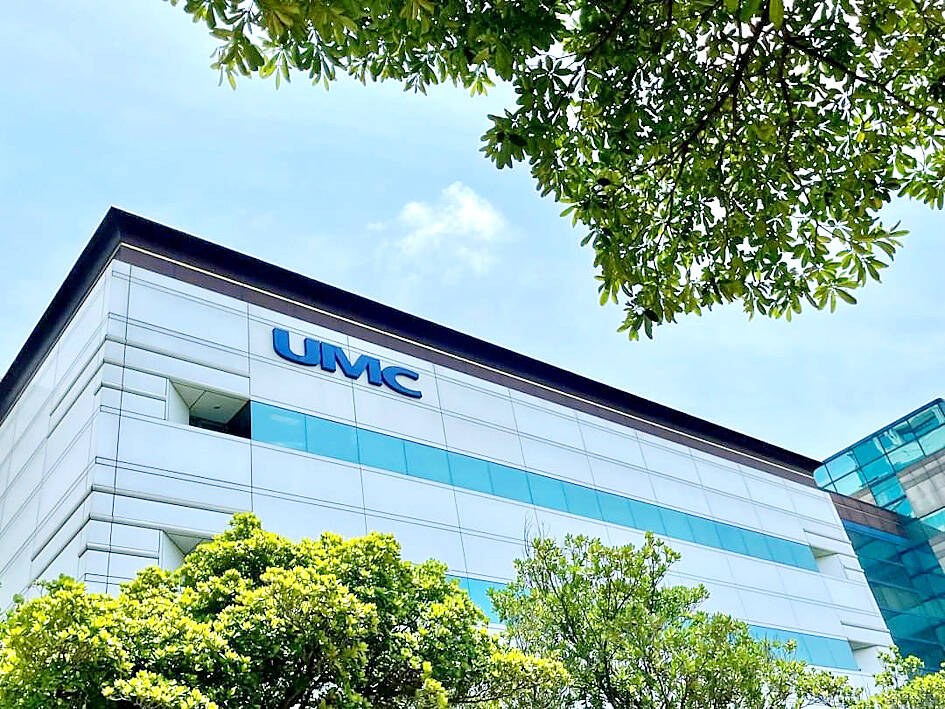United Microelectronics Corp (UMC, 聯電) expects revenue to remain stable this quarter amid slightly better-than-expected demand for its computer segment, bucking the usual seasonal downturn during the final quarter of the year, the company told an online investor conference on Wednesday.
That was based on UMC’s expectations that wafer shipments would remain flat this quarter. In addition, the average sales price would be unchanged this quarter, which it attributed to its optimized and differentiated technology offerings.
UMC’s revenue last quarter rose to NT$60.49 billion (US$1.89 billion), the strongest level in about seven quarters. Communication chips were the biggest revenue source, accounting for 42 percent of the chipmaker’s total sales last quarter. Consumer chips came next with a 31 percent share, while computer chips only made up 13 percent.

Photo: Grace Hung, Taipei Times
“With regards to the fourth-quarter outlook, we are seeing demand stabilizing across the end market and a clear downward trend in inventory levels,” UMC co-president Jason Wang (王石) said.
“For the fourth quarter, we expect the trend in the computing segment would be slightly better quarter-on-quarter than we originally expected. However, that would be offset by a mild decline in the communication and consumer segments,” Wang said.
Gross margin is to drop to about 30 percent this quarter, which would be the lowest in one-and-a-half years, down from 33.8 percent last quarter. UMC attributed the decline to higher depreciation costs on facilities and manufacturing equipment.
Depreciation costs are to swell 20 percent year-on-year this year, and the uptrend would extend into next year, UMC said.
When the depreciation costs start to wane and drop to the normal range after next year, the gross margin would rebound to 40 percent, Wang said.
UMC aims to keep its margin of earnings before interest, taxes, depreciation and amortization stable at about 42 or 43 percent, he said.
Lower equipment utilization is also a factor weighing down gross margin, which is to slide to 66 to 68 percent this quarter from 71 percent last quarter, due to a larger capacity base.
UMC on Wednesday trimmed its estimated capital spending for this year to US$3 billion from an earlier estimate of US$3.3 billion.
UMC said that its partnership with Intel Corp on developing 12-nanometer technology remains on track. The first 12-nanometer chip is to come out in 2026, the chipmaker said.
As for its progress in offering silicon interposers that are used in the older version of advanced chip-on-wafer-on-substrate packaging technology, Wang said UMC has doubled its interposer capacity to 6,000 wafers a month.
UMC has engaged with multiple customers to supply interposers next year and is in discussions with customers to increase supply, he said.
The company on Wednesday posted its best quarterly net profit since last year at NT$14.47 billion, up 5 percent sequentially from NT$13.79 billion. On an annual basis, net profit contracted 9.4 percent from NT$15.97 billion.
The revenue contribution from its 22-nanometer and 28-nanometer technology rose to 35 percent from 33 percent in the prior quarter.

Intel Corp chief executive officer Lip-Bu Tan (陳立武) is expected to meet with Taiwanese suppliers next month in conjunction with the opening of the Computex Taipei trade show, supply chain sources said on Monday. The visit, the first for Tan to Taiwan since assuming his new post last month, would be aimed at enhancing Intel’s ties with suppliers in Taiwan as he attempts to help turn around the struggling US chipmaker, the sources said. Tan is to hold a banquet to celebrate Intel’s 40-year presence in Taiwan before Computex opens on May 20 and invite dozens of Taiwanese suppliers to exchange views

Application-specific integrated circuit designer Faraday Technology Corp (智原) yesterday said that although revenue this quarter would decline 30 percent from last quarter, it retained its full-year forecast of revenue growth of 100 percent. The company attributed the quarterly drop to a slowdown in customers’ production of chips using Faraday’s advanced packaging technology. The company is still confident about its revenue growth this year, given its strong “design-win” — or the projects it won to help customers design their chips, Faraday president Steve Wang (王國雍) told an online earnings conference. “The design-win this year is better than we expected. We believe we will win

Chizuko Kimura has become the first female sushi chef in the world to win a Michelin star, fulfilling a promise she made to her dying husband to continue his legacy. The 54-year-old Japanese chef regained the Michelin star her late husband, Shunei Kimura, won three years ago for their Sushi Shunei restaurant in Paris. For Shunei Kimura, the star was a dream come true. However, the joy was short-lived. He died from cancer just three months later in June 2022. He was 65. The following year, the restaurant in the heart of Montmartre lost its star rating. Chizuko Kimura insisted that the new star is still down

While China’s leaders use their economic and political might to fight US President Donald Trump’s trade war “to the end,” its army of social media soldiers are embarking on a more humorous campaign online. Trump’s tariff blitz has seen Washington and Beijing impose eye-watering duties on imports from the other, fanning a standoff between the economic superpowers that has sparked global recession fears and sent markets into a tailspin. Trump says his policy is a response to years of being “ripped off” by other countries and aims to bring manufacturing to the US, forcing companies to employ US workers. However, China’s online warriors